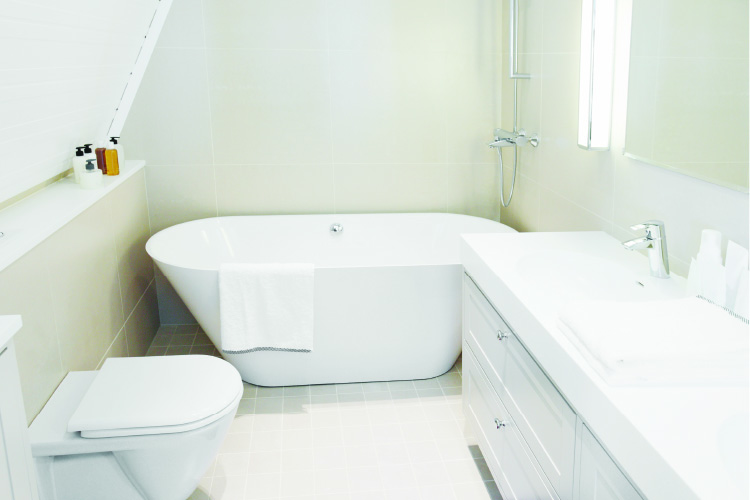Most bathrooms sparkle on the surface, but does that mean they’re clean? There could be more than germs lurking in our bathrooms than your eyes can see. Cleaning your bathroom, and that too via ‘green cleaning’ is much easier than you would’ve envisioned. Here are some simple homemade bathroom cleaning solutions that will not only save you money but also protect your family’s health and the environment. The best part is, with a do-it-recipe, you’re assured that you’re going as green as possible, since you know exactly what went into the products you’re using.
Eco-friendly, non-toxic cleaning ways is so important because conventional surface cleaners, scouring powders, and toilet cleaners come packed with an arsenal of toxic and corrosive chemicals that are dangerous to our health and to the environment:
Table of Contents
Health Concerns
Ingredients with high acute toxicity include chlorine bleach and ammonia, which produce fumes that are highly irritating to eyes, nose, throat and lungs, and should not be used by people with asthma or lung or heart problems. These two chemicals pose an added threat in that they can react with each other or other chemicals to form lung-damaging gases.
- Triclosan is a common ingredient used in anti-bacterial and anti-microbial cleaners and it contributes to the increasing problem of drug-resistant bacteria. Triclosan can cause infertility, birth defects, and damage to major body organs. Also, studies have shown that triclosan can combine with chlorine in our tap water to make chloroform gas.
- Isopropanol, also known as rubbing alcohol, is a nervous system depressant.
- d-Limonene is a high-odour volatile organic compound that irritates skin and eyes.
- Pine oil is irritating to mucus membranes and harmful or even fatal when ingested.
Environmental Concerns
- Some chemical ingredients do not break down into harmless substances in the environment, and thus threaten water quality or fish and other wildlife.
- Many use chemicals that are petroleum-based, contributing to the depletion of this non-renewable resource and increasing the dependence on imported oil.
- The plastic bottles used to package cleaning products contribute to the mounds of solid waste that must be put in a landfill, incinerated, or, in not enough cases, recycled.
What you need
- Spray bottle
- Vinegar
- Baking soda
- Toilet brush
- Soft cloths
- Old toothbrush
- Hydrogen peroxide
- Tea Tree or Lavender Essential oil
Bathroom Mold in Shower
Mold in bathroom tile grout is a common problem and can be a health concern. Here are several options for a natural mold remover:
- Mix one part hydrogen peroxide (3%) with two parts water in a spray bottle. Spray on areas with mold. Wait at least one hour before rinsing or using shower.
- Pour some white distilled vinegar straight into a spray bottle, spray on the moldy area, and let set without rinsing. The smell will dissipate in a few hours. Vinegar kills 82 percent of mold. Remember that vinegar can break down tile grout, so use sparingly.
- Mix 2 cups water and 2 teaspoons tea tree oil. Combine in a spray bottle, shake to blend, and spray on problem areas. Do not rinse. The smell of tea tree oil is very strong, but it will dissipate in a few days.
- A half a lemon dipped in sodium borate (sodium, boron, oxygen and water) will also scour the mildew out of the cracks in your tub and tile. Be careful around children and pets, as as it can be toxic if swallowed.
Bathtub
For a natural soap scum remover, apply baking soda (it is non-abrasive) and then sprinkle with water or vinegar. Scrub with a damp cloth or sponge; for tough-to-remove soap scum, use a bristle brush.
Sink
For a natural sink cleaner, simply scrub with baking soda and water.
Countertops
For a natural countertop cleaner, add water and vinegar to a spray bottle (in a 1:1 ratio) and spray. However, do not use vinegar on marble, granite, or other stone countertops as it may etch the stone surface.
Drain
Chemical drain cleaners are one of the most toxic cleaning products. These caustic mixtures commonly contain lye, bleach, or sulfuric acid and can cause damage to skin, lungs, and eyes. Instead of messing with chemicals, all you need is baking soda and apple cider vinegar.
For a natural drain cleaner, pour 1/2 cup to 1 cup baking soda down the drain and then add apple cider vinegar. Let it bubble for 15 minutes and then rinse with hot water.
Glass and Windows
Commercial window cleaners contain many toxic ingredients such as ammonia and butyl cellosolve (a toxic ingredient that is not listed on the labels). Also, by buying commercial glass cleaners, you are going through many, many bottles, not to mention paying a high price for a product that is 95% water!
To clean mirrors, create your own natural glass cleaner with vinegar and water; it is much safer. Combine equal parts water and white vinegar in a spray bottle and shake well. Spray and wipe, using a micro-fibre cloth. Do not use newspaper, which contains toxic dyes, or paper towels, which contribute to waste.
Toilet
Most toilet bowl cleaners are highly acidic and can irritate lungs and burn eyes. For a natural toilet cleaner, spray vinegar around the bowl, sprinkle with baking soda, and scrub it with a toilet brush. This solution will clean and deodorise.
Another option is to use sodium borate – a naturally occurring alkaline mineral that is a powerful disinfectant and deodoriser. Toss 1/2 cup in your bowl, wait a half an hour, then scrub.
















